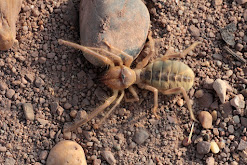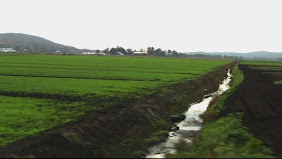Friday, July 29, 2022
The Drowned Lands: New York’s Black Dirt Region
Monday, July 18, 2022
What’s This Bug? The Solufigid/Camel Spider.
When the US military went into Iran and other parts of the desert Middle East, our troops came across these unusual-to-them creatures and, of course, told everyone back home about them. They adopted the prominent name from the area, camel spiders (For clarity, I’m going to use this name for the remainder of this blog). This awareness of camel spiders to Americans, spawned many urban myths. It just so happens that the misconceptions highlight some of the most unique aspects of this creature. It’s been said:
- that camel spiders are spiders from Hell.
Clearly these creatures are not literally from the underworld. In fact, they are not true spiders, although they come from the Arachnid genus. There are over 1,000 species of camel spiders, and none have the correct anatomy to qualify as spiders. They do have the eight legs (the two front “legs” are called palps and function more as feelers or hands for grasping prey), but little else a spider has. They don’t have venom or spinnerets. Additionally, spiders have separate heads and thoraxes, while camel spiders have a large one-piece head/thorax combination (which takes up 1/3 of its body).
These are animals that avoid the sun and/or daylight exposure. In fact, the Solifugae name is derived from Latin and means “fleeing from the sun”. If caught out in the sun, they will rush into whatever shade they find and sometimes that is the shade a human is making. They’ve also been known to use a walking person’s shadow as moving shade, which makes it seem they are chasing that person. At night, they will rush towards any light they see, including flashlights and campfires. Seeing them approaching rapidly from the darkness would give anyone a fright.
- that camel spiders can grow to the size of a dinner plate.
 A widely-shared picture from Iraq shows soldiers holding two locked-together gigantic camel spiders. While this made for titillating conversation, the photo is a classic case of false perspective. Camel spiders in the Middle East don’t grow to more than 2“, and most are around 1”. If you consider that dinner plates are 10½-12” in diameter, it’s clear just how much their size has been exaggerated.
A widely-shared picture from Iraq shows soldiers holding two locked-together gigantic camel spiders. While this made for titillating conversation, the photo is a classic case of false perspective. Camel spiders in the Middle East don’t grow to more than 2“, and most are around 1”. If you consider that dinner plates are 10½-12” in diameter, it’s clear just how much their size has been exaggerated. - that camel spiders can jump up to 6 feet and run up to 25 mph.
 In reality, camel spiders are not good jumpers. However, their chief hunting behavior is to run at breakneck speed towards their prey. I mean run – while they can’t go 25 mph, they can do 10 mph. And they can keep up this speed indefinitely; there is no “slow” switch. Once night falls, they barrel out of their hiding places and start running. According to this man, they have a preferred route that they transverse over and over. While this article tells of researchers who tried to keep up with these speed demons and had to give up after a non-stop two-hour dash. As it zooms around, a camel spider will attack and devour any prey that is unfortunate enough to cross it’s path. They will literally run into something, rear up, slap/grab it with their palps and then begin chewing on it immediately. In no time, the camel spider will have shredded, liquified and consumed It and be off looking for something else. As horrifying as this running-attacking seems to be, camel spiders should be considered beneficial due to some of their food choices. Their diet is varied and includes many creatures that are deemed undesirable by humans, like venomous insects, spiders, scorpions and centipedes. Here's a video showing an attack on a millipede that shows just how fast they work (it is not sped-up, it’s in real time).
In reality, camel spiders are not good jumpers. However, their chief hunting behavior is to run at breakneck speed towards their prey. I mean run – while they can’t go 25 mph, they can do 10 mph. And they can keep up this speed indefinitely; there is no “slow” switch. Once night falls, they barrel out of their hiding places and start running. According to this man, they have a preferred route that they transverse over and over. While this article tells of researchers who tried to keep up with these speed demons and had to give up after a non-stop two-hour dash. As it zooms around, a camel spider will attack and devour any prey that is unfortunate enough to cross it’s path. They will literally run into something, rear up, slap/grab it with their palps and then begin chewing on it immediately. In no time, the camel spider will have shredded, liquified and consumed It and be off looking for something else. As horrifying as this running-attacking seems to be, camel spiders should be considered beneficial due to some of their food choices. Their diet is varied and includes many creatures that are deemed undesirable by humans, like venomous insects, spiders, scorpions and centipedes. Here's a video showing an attack on a millipede that shows just how fast they work (it is not sped-up, it’s in real time).
- that camel spiders will screech as they attack.
They do not scream (again, an anatomy thing), but their powerful jaws can cut through feathers, bones and shells and that could create an ugly sound. And some species do clack their jaws as they attack. Or perhaps the noise in question is that of onlookers screaming in horror.
 - that camel spiders lay their eggs in animal’s fur (particularly camels) and eat camel bellies.
- that camel spiders lay their eggs in animal’s fur (particularly camels) and eat camel bellies.
Camel spiders are not parasitic, nor are they blood-eaters, so they have no reason to seek out an animal host to lay their eggs on. They lay them in out-of-sight and underground places like burrow and under rocks or logs. As far as eating camels goes, these arachnids are fierce and have a varied diet, but it does not include large mammals (although a small mammal may become a meal if it runs into it).
Camel spiders have so many interesting behaviors, but my favorite is their ant-slaughtering. It appears that they like to accost ants at the opening to their colony and cut them to pieces as they come out to defend their home. The camels spiders are not eating the ants, they are simply killing them. And in a way that seems almost gleeful. Scientists have theories (scientists always have theories), but there is no real explanation for these attacks. Be that as it may, this behavior is inexplicably mesmerizing to watch. Here’s a video and here’s another.
Submitted by Pam
Featured Post
Being Thankful at ARBICO
Here at ARBICO Organics we have a lot to be proud of – and thankful for. We are a small, family-owned company that has grown and prospered t...

-
Entomopathogenic Nematodes Ever heard of a NEMATODE? You might be more familiar with their colloquial name, which is roundworm. For the p...
-
I recently had a knee injury and was ordered to stay off it for a couple of weeks. During my forced vacation, I spent most of my time on th...
-
Our ARBICO Organics Beneficial Nematodes are one of our most popular and most effective controls for a wide-range of insect pests. These ...



















